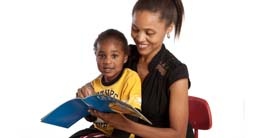 Kick start your child’s pre-literacy and language skills by focusing on these areas while reading books with them. Children who develop these skills at an early age are more likely to become fluent readers and better spellers than children who do not. We define these skills as phonological awareness, which is the ability to recognize, manipulate, and use the sound structure of spoken language.
Kick start your child’s pre-literacy and language skills by focusing on these areas while reading books with them. Children who develop these skills at an early age are more likely to become fluent readers and better spellers than children who do not. We define these skills as phonological awareness, which is the ability to recognize, manipulate, and use the sound structure of spoken language.
- Rhyming: Words that have the same ending sound. Children start becoming interested in syllables and rhymes as early as 12-36 months of age.
- Explain that rhyming words are words that sound the same at the end. As you read the story with your child, draw attention to the rhyming words. e.g. “I heard rhyming words!-- Words that sound the same at the end like ‘bear’ and ‘chair’.”
- Ask if two words rhyme. “Do ‘goat’ and ‘coat’ rhyme?”, “Yes, they both end with ‘oat’. They rhyme!”
- Have your child attempt to finish phrases or sentences with a rhyming word (e.g. “The cat in the …”).
- Pick words in the book and help them think of a word that rhymes e.g. “What rhymes with bear?--- Chair or bee? ‘Bear’ and ‘chair’ both end with ‘air’. They rhyme!”
- Segmenting Syllables: Identifying the individual sounds in a word.
- Explain to your child that you are going to listen to words and figure out how many beats (syllables) are in each word. As you read the story, pick words from the story and clap out the syllables in the words together e.g. “Let’s see how many times we clap for Frog. (clap together) One time! The animal character in this book has 1 beat. Let’s try another: Butterfly. But-ter-fly (clap 3 times). We clapped 3 times. There are 3 beats in butterfly!”
- Identifying Initial and Final Sounds
- As you read the story, pick words from the story and ask what sound your child hears at the beginning and/or end of the word. Emphasize the sound as you say the words e.g. “What is the first sound in the word fffffffrog? That’s right-- The /f/ sound! It sounds like an angry cat, /ffff/. Look how I make the sound. Bite your lip gently and blow for the /f/ sound.”
- Print Orientation
- Talk about and point out the front/back cover, top/bottom (opposites), spine, words, pictures, author, illustrator, title, and characters. Tell them what an author and illustrator do and what a character is.
- Before you begin reading, hold a book upside down and have your child “catch you” and correct the orientation of the book.
- Draw attention to speech bubbles and punctuation as you read the story, and trace the words as you read. Point out large print and explain how when it is written bigger/smaller, that means the character is saying it loudly/quietly.
For more information about pre-literacy skills:
https://blog.chsc.org/blog/pre-literacy-skills-for-preschoolers
For more information about shared book reading and preschool literacy: https://www.chsc.org/resources/news/new-preschool-language-and-literacy-classrooms-pllc-program/









